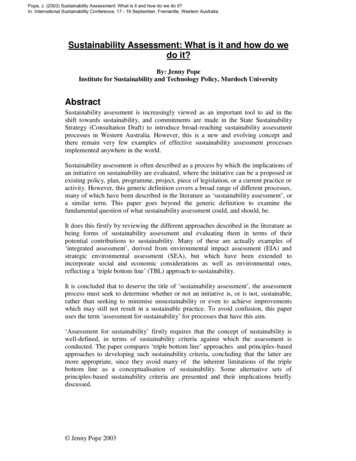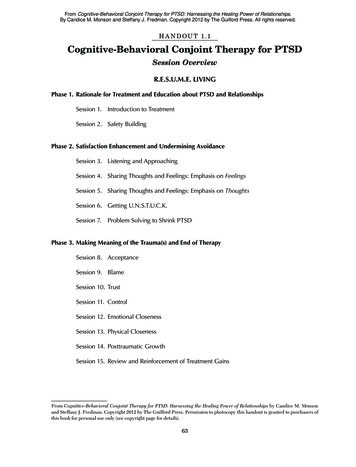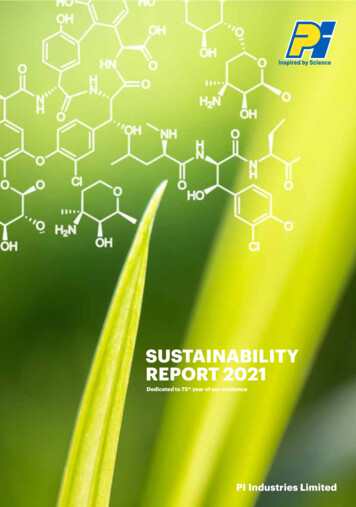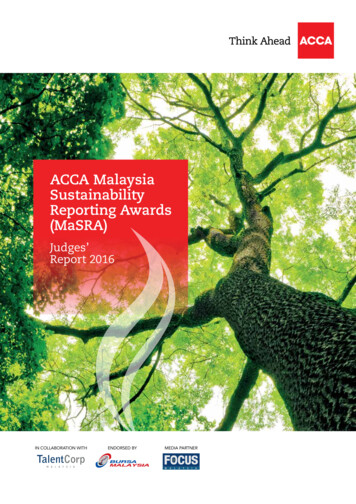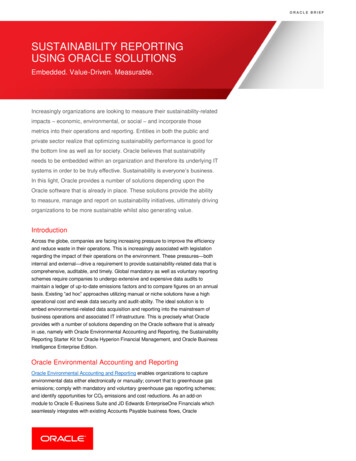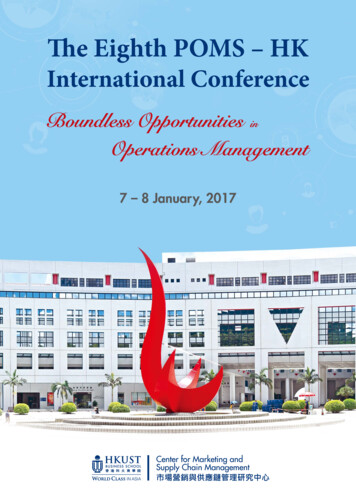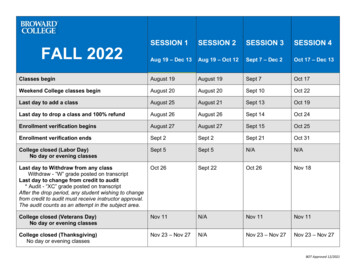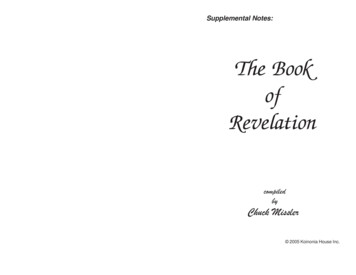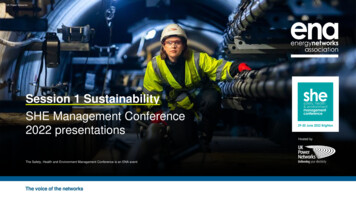
Transcription
UK Power NetworksSession 1 SustainabilitySHE Management Conference2022 presentationsHosted byThe Safety, Health and Environment Management Conference is an ENA event
2022 ENA SHE MANAGEMENT CONFERENCESustainability & UKbusiness approachAleyn Smith-GillespieDirector, Carbon Trustaleyn.smith-gillespie@carbontrust.com
OUR MISSIONTo accelerate the move toa decarbonised future.
THE CARBON TRUSTWe bring our customers on a journey towards climate leadershipOrganisational footprintingStart to understand your carbon footprint, measureyour Scope 1 and 2 emissions and build awarenessof your organisation’s impacts.Value chain footprintingAssess the wider emissions in your upstream anddownstream activities, calculate your Scope 3 emissionsand increase your understanding of the broader impactsof your business.Science-based target settingSet ambitious and climate-science aligned targets to reduceyour carbon emissions and to demonstrate yourorganisation’s commitment to sustainability.Certification and disclosureStrategic sustainability adviceDevelop a long-term plan on how you will achieve yourtargets. Assess the feasibility of your strategy: modelexisting initiatives, identify new ones, define the mostrelevant KPIs.Communicate your efforts to the public with a robustthird party validation. Build a strong message around theadoption of international standards and frameworks.3
Context4
Context to science-based targets Global temperatures have risen by more than 1 C since pre-industrial times. Paris Climate Agreement approved by 197 nations at COP21 came into force on 4thNovember 2016. Agreed to hold the increase in global average temperatures well below 2 C and pursueefforts to limit the increase to 1.5 C. Emissions should peak as soon as possible, and rapidly reduce thereafter.5
Global commitments are accelerating the adoption ofambitious objectives to tackle climate change2018: Intergovernmental Panel on ClimateChange (IPCC) report showed that we need toalign to a 1.5 C trajectory. The world needs toreach Net Zero CO2 emissions (emissionsbalanced with removals) by 2050.The Paris Agreementwith a goal to limit globalwarming to well below2 C and to pursue effortsto limit to 1.5 CJune 2021: G7reconfirmed theircommitment to limitingwarming to 1.5 C.May 2021: EU climatelaw – Net Zeroemissions are now abinding target for 2050.6
However, under current policies we are heading towards a 2.7Ctemperature increaseTransition risks will depend on the level of decarbonisation and our preparedness to adapt to a low-carbon economyAs we strive to reach the ParisAgreement’s goal of 1.5 Ctemperature increase, we canonly mitigate growingexposure to transition risksthrough early action and anorderly decarbonisation.Source: Climate Action Tracker7
The difference between global warming of 1.5 C and 2 C isvastA 1.5 C world is one that is more economically stable, in which supply chains are less susceptible to flood and extremeweather risks; workforces are less exposed to extreme heat, water scarcity and food shortages; and company operationsare less at risk from dramatic changes to water supplies.1.5 CGlobal populationexposed to severe heat atleast once every 5 yearsNumber of ice-free articsummersFurther decline in coralreefsDecline in marine fisheriesSBTi net zero launch webinar2.0 C2 C14%37%2.6x worseAt least 1 every 100yearsAt least 1 every 10years10x worse70-90%99%Up to 29% worse1.5M tonnes3M tonnes2x worse8
Drivers for action towards a Net Zero transition are strong andgrowingBuyersPolicies ®ulationsTechnologyEmployeesInvestorsSupply chain
Is it just about risks?Those than can adapt and implement early action will benefit from the opportunities of a just transition to a net-zero world10
The road to Net Zero: Science-based andlong-term targets11
The Science Based Targets Initiative (SBTi) has translated theglobal goals into decarbonisation pathways for companies Majority of all science-based targetsvalidated by the SBTi in 2021 havebeen 1.5C-aligned for Scope 1&2 (themost ambitious pathway forreduction). Growing number of companies havenow committed to achieving net-zeroemissions by 2050.Source: Science Based Targets Initiatives (Figures as of 26 June 2022)12
The SBTi describes the end goal of Net Zero and the journeytowards achievement1. Near-term sciencebased target2. Long-term sciencebased target3. Beyond value-chainmitigation4. NeutralisationSource: Science Based Targets initiative13
Companies need to address both their Scope 1&2 emissions(own operations) as well as Scope 3 emissions (value chain)Scope 3 (Upstream)Supply chainOwn operationsScope 1 & 2Scope 3 (Downstream)Distribution, use anddisposal of sold products14
What does Net Zero mean for the PowerSector?15
Why is setting a net zero target in the utilities/energy sectorimportant? Net zero includes all scope 1, 2 and 3 emissions to be accounted when settingreduction and neutralisation targets. The world has a viable pathway to building a global energy sector with net-zeroemissions in 2050, but it is narrow and requires an unprecedented transformation ofhow energy is produced, transported and used globally (IEA 2021)IEA 2021World Resources Institute 202016
SBTi Net-Zero Standard for power companiesSector-specific intensity pathwaysNet-Zero Standard for long-term targetsfor power companies:Long-term targetfor powergeneration:0.009 kgCO2/kWh97% reduction Must achieve Net Zero by 2040 and usethe intensity convergence method(SDA). If scope 3 emissions 40% of total:companies must set an intensity targetcovering all sold electricity (includingpurchased and resold electricity inscope 3 category 3).17Source: Science Based Targets Initiative
UK Power sector emissions trajectory to 2037Indicative power emissions pathway to2037 in the UK Net Zero StrategyKey emission reduction milestones(vs. 2019 base year)(1) 2030: 71-76% reduction 2035: 80-85% reduction 2050: 95-98% reduction18Source: UK Net Zero Strategy: Build Back Greener (BEIS, 2021)
By 2050, the economy will need to be powered by zero-carbonelectricity and hydrogen; residual fossil fuel usage will be minorUK energy generation and end uses in 2050(High electrification scenario)Net Zero Strategy Commitments to deliver adecarbonised power system by 2035 (selected) By 2035, all electricity will come from lowcarbon sources (mainly wind and solar). Maximise system flexibility throughdelivering smart and digitalised energysystem. Create a whole energy system governanceto achieve both Net Zero and consumerneeds (e.g. proposal for ‘Future SystemsOperator’ with responsibilities across bothelectricity and gas systems).19Source: UK Net Zero Strategy: Build Back Greener (BEIS, 2021)
The role and value of smart technologies in a 2050 net zero systemA portfolio of flexibility acrossthe energy system managesuncertainties and reducescostsInvesting in flexibility is ano-regrets decision as itdelivers material netsavings of up to 16.7bn/year in 2050Embedding flexibility in zerocarbon heat & transportsolutions will help to reducetheir system impact & costsDemand side flexibility, enabled bysmart technologies, reduce systemcosts by up to 4.6bn/yr in 2050Source: Flexibility in Great Britain (Carbon Trust; Imperial College)20
Key elements of a transition plan21
Net Zero targets still bring a lot of uncertainties and questionsRobustness of thetargetValidation of achievedreduction over timeFeasibility of theimplementation planTracking andcommunicationHow do I ensure thatthe level of ambition,baseline, boundaries,offsetting andremovals strategiesare appropriate?How can I verify theprogress achieved overtime, to make sure Iwill meet myobjectives?Do I have the correctfinancial andoperational planningto achieve mytargets?How can Icommunicateinternally and to thewider public theprogress on myambition?*Source: Accenture (2021)22
What does leadership look like?Targets*Climate risks andopportunitiesMonitoringReporting*Data collection& accountingResponsibility*Supply oducts onalcontrolCapitalexpenditure &investments23
Presence of a qualifying Net ZerotargetTargetsAppropriate public reporting of GHGEmissionsClimate risks andopportunitiesMonitoringFully accessibility of GHG emissionreporting on public communicationReportingData collection& accountingResponsibilitySupply chainengagementPolicyDemonstrated senior executive(s)leadership in carbon managementPresence of accountabilityframeworks and accountablepersonnel for carbon reportingTop management actively involved inthe creation of the policyCustomerengagementStrategyProducts onalcontrolCapitalexpenditure &investmentsEnvironmental policy communicatedboth internally and externallyGroup strategy should recognise theuse of GGRs for achievement of NetZero targetAppropriate and detailed investmentplan to achieve carbon reductiontargets24
Conducting a transition risk assessmentIdentifyAnalyseMitigate2.1.Identify transition risks based on your business strategy,sectoral developments, and climate science & policyDefine business context4.3.Detailed assessment of the mostmaterial risksAssess the external drivers of andinternal exposures to risk5.6.Integrate findings with board levelbusiness planning and strategyDevelop metrics & targetsfor material transition risks25
Companies need to forward plan investments and actionsIllustrative decarbonisation pathwayReduce carbonintensity of growth160140120100Carbonemissions Scope 1&2 Scope 38060- 90% ear-termtargetGrowthDecarbonisationLong-termNet Zerotarget5-10 yearsfrombaseline26
Focus: Scope 3 decarbonisationScope 3 (Upstream)Supply chainOwn operationsScope 1 & 2Scope 3 (Downstream)Distribution, use anddisposal of sold products27
Key levers for decarbonising Scope 3 emissionsPurchasedgoods andservices Product designCircular products andbusiness modelsUpstreamtransport anddistribution Supply chain optimisationCollaboration More energy efficientproducts in-useEnd-user behaviourCircular products andbusiness modelsUseof soldproductsDownstreamtransport anddistributionEnd of lifetreatmentSource: Carbon Trust Logistics optimisation RecyclingCircular economy /regenerative resource useLandfill vs waste-to-energy 28
To drive change at scale, three key aspects will need to work insynergyMeasurement,Verification, assuranceand reportingCarbon reduction actionsand innovationGreen financing29
Key insights and learnings from over 150 SBT projects deliveredCompanies face similar challenges Receiving buy-in from across thebusinessUnderstanding evolving SBTirequirementsMeasuring value chain emissionsValue chain target-setting but there are ways to address theseEarly and continuous engagement withkey stakeholdersGood data collection processes thatimprove with timeClear business case and long-terminvestment planHow to achieve the targetGetting the target approvedExternal support to ensure best practice30
Thanks forlisteningAleyn Smith-GillespieDirector, Business Servicesaleyn.smith-gillespie@carbontrust.com31
ENA SHEconference 2022How we are innovating toachieve Net ZeroIan Cameron & Shira Lappin
Our corporate Vision is evolvingEnabling Net Zero has two key components:1. Achieving Net Zero as a business through our own operations and supply chain2. Facilitating Net Zero through our network by accelerating the decarbonisation ofelectricity, transport and heat.2
Our Customers’ Top 3 PrioritiesCostClimate ChangeCustomerVulnerabilityOur key areas of innovation are where these priorities overlap3
Enabling the Net Zero Transition for AllDecarbonising Electricity9.4GW of Distributed generationconnected, 7.3GW renewableDecarbonising Transport230k Plug-in vehicles charging offour network today, volumesmultiplying annually10GW DG accepted, not yetconnectedForecasting 2.6 - 4.5m EVs by 2030370MW of storage connected, 3 GWaccepted and yet to connect18,500 Public charge points, 38% ofthe countryDecarbonising Heat28,000 heat pumps connected to ournetworks today2025 Future homes standard willdrive volumes of heat pumps, by 2028gov expect 800,000 a year nationallyBy 2030 we expect 712,000 - 1.2m toconnect to our networkBy 2030 Generation to reach13.5GW Inclusive by Design4
Innovating to Decarbonise ElectricityPOCmastProvides an additional cost effective option for customerswishing to connect to the network and avoid the costly andtime consuming option of complete tower replacement.Includes a base hinge to enable construction work to be doneat ground level before erecting the mast.Cost around 60k to design and the first trial saved a solarfarm connected 500kSmarter Network Storage- 6MW/ 10MWhDelivering multiple system services through differentcontracting mechanismsTested and published analysis on different businessmodels and value of available servicesProvided Government, Ofgem and the industryinsight to the regulatory and commercial barriers ofstorageShared experience of building, operating and sellinggrid scale storage5
Innovating to Decarbonise TransportVoyage (NIA)V2GV2G (IUK/ NIA)Large V2G mass trials with 135customers participatingProduced a low weight small V2G charger- reducing the costof a V2G charger by over 50%Developed a self-service product for domestic customersseeking an electricity supply upgrade to connect an LCT.76% of these applications are processed automatically,reducing lead times from 10 days to a matter of minutes.Optimise Prime NICThe world’s largest dataset on commercialEV usage and chargingA solution for home charging of commercialEVs, with separate billing & flex aggregationA suite of tools, e.g. depot planningmodel, allowing an easier switch to EVProfiled Connection’ enabling more efficientuse of network capacity6
Innovating to Decarbonise HeatHyCompact (NIA)Hybrid heat pumps reduce space requirements by 50% and can beinstalled in a third of the time compared to dual-unit hybrids43% reduction in carbon emissions due to switching to a hybridheat pump and increased heating system efficienciesHeat pump only operation is perfectly viable in milder conditions,in colder weather, boiler utilisation increases and COP falls, butgood carbon savings are still achievedCommuniHeat (NIA)CommunityEngagement CommunityFinanceModelsCommunity renewables deliver 37% of totalelectricity demandSystemStudiesCoordinated /UncoordinatedTrialDesignModelling indicates up to75% saving in networkreinforcement costsBook onDecarbonisingOff-Gas Grid Increased buildingretrofits 20% energy saving7
Developing a Culture of Innovation to Achieve Net ZeroDiversify theinnovationfunding streamsPut more financial skin in the game, win more innovation funding andleverage existing regulatory funding to participate in wider innovationinitiativesFocus onproblems whichdeliver valueTreat innovation as a business, do what matters to our customers andstakeholdersMaximiseCollaborationAim to undertake approximately 50% of projects in collaboration withother Licensed Network Operators ( LNOs)Being transparenton the benefitsdeliveredTransparently report on the lessons learnt, there is no negativeinnovation learning!Taking on agreater social roleFocus the innovation approach to new themes which deliver SocialReturn On Investment, not simply network benefits – focus on NetZero and customer vulnerabilityEnsures innovation andsustainability as BAU, bringingeveryone on the journey toguarantee buy-in and deliversuccessEssential for achieving ourcorporate goal of enabling theNet Zero transition for all, bothachieving and facilitating8
Vulnerability is Evolving As the energy sector evolves towards a decarbonised, decentralised and digitalised system, our customers areexperiencing new barriers in engaging with the energy market and energy solutions, leaving them at risk of beingdisadvantaged. Tariff checking and switching guidance How to read a meter and avoidestimated bills Supplier initiatives and guidance oneligibility Income maximisation Water and energy efficiencyadvice/behavioural changes Tailored efficiency, behavioural advice Personalised support on tariff checkingand switching Energy efficiency interventions Practical help to check eligibility andsecure grants Income maximisation services
which barriers can drive customers towards exclusion ordisadvantage in the changing energy system?To better understand which barriers can drive customers towards exclusion or disadvantage in the evolving energysystem we have developed a two stage exclusion segmentation framework, focusing on which barriers in the energysystems we can break to ensure inclusive services and a just energy transition, as well as on the personal circumstancesthat may put people at risk of being left behindOur two stage exclusion segmentation framework Tariff checking and switching guidance How to read a meter and avoidestimated bills Supplier initiatives and guidance oneligibility Income maximisation Water and energy efficiencyadvice/behavioural changes Tailored efficiency, behavioural advice Personalised support on tariff checkingand switching Energy efficiency interventions Practical help to check eligibility andsecure grants Income maximisation services
Socially GreenBetter understanding customer vulnerability, d riven by multiple data setsOur Socially Green geospatial mapping and forecasting tool currently embeds: 43 vulnerability data sets from a range of data sources (e.g. ONS, Experian, Census 2011, GovUK, Ofgem, FCA, CSE) These indicators define a series of circumstances that are likely to result in vulnerability,disadvantage and exclusion now and in the future: 17 Themes (longer term) and 10 Events(shorter term or temporary) By combining this data we have mapped out 10 segments of exclusion Tariff checking and switching guidance How to read a meter and avoidestimated bills Supplier initiatives and guidance oneligibility Income maximisation Water and energy efficiencyadvice/behavioural changesExample: “Lack of opportunity to participate in the energy sector” level in 2020and difference in accessibility between 2020 and 20301.58mhouseholds at risk of beingleft behind by 2030in the energy system acrossour areas on averageper segment of exclusion Tailored efficiency, behavioural advice Personalised support on tariff checkingand switching Energy efficiency interventions Practical help to check eligibility andsecure grants Income maximisation services
EnableHelping disabled drivers who park on street switch to electric vehiclesObjectives: To understand the barriers facing disabled customersin the switch to EVs, the role of the DNO in supporting thesecustomers and to assess the impact on the network.We: Surveyed over 1,000 disabled motorists Interviewed 20 local authorities, central government and fivecharge point operators Market sizing of disabled customers in the UK Power Networkslicence area. Network impact assessment of the electrification of on-streetdisabled parkingKey barriers relating tothe accessibility of onstreet charge pointsfor disabled users fallinto 4 main categories:Variety of usersSuitability ofcharge pointsBuilt environment,infrastructuralInformational745,000 Blue Badge holders in the UKPower Networks licence area by 2030:Project partner:12
Right to HeatTrialling low carbon heating interventions in social housingObjective: to develop and demonstrate a template for best practice for decarbonising heating in urban socialhousing settings by unlocking the commercial value of LCTs for consumers.We are: Trialling low carbon interventions: hybrid system (heat pump working alongside a traditional boiler) coupled withsolar PV and energy storage and smart market mechanism Gathering feedback on consumer impact and evaluating the impact on customers in vulnerable situations andfuel poverty Providing the customers with longer term energy advice and coachingBenefits to CustomersProject partners:1. Achieve lower consumer bills2. Reduce tenants’ carbon footprint3. Improve wellbeing and health of customers by ensuring homesare kept warm13
Thank youhttps://innovation.ukpowernetworks.co.uk/14
UK Power NetworksThank youSee you in Dublin for SHEManagement Conference 2023Hosted byThe Safety, Health and Environment Management Conference is an ENA event
SHE Management Conference 2022 presentations Hosted by The Safety, Health and Environment Management Conference is an ENA event UK Power Networks. . Scope 3 (Upstream) Supply chain Own operations Scope 1 & 2 Scope 3 (Downstream) Distribution, use and disposal of sold products. Key levers for decarbonising Scope 3 emissions 28

